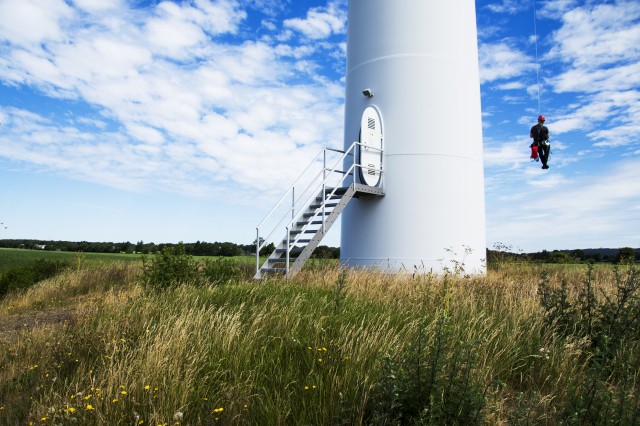Working in and around wind turbines, both onshore and offshore, faces a wide variety of risks. Working with heights, working in machines, working in tight spaces or working in a complex environment. Think, for example, of working in the nascel, in the crawl space, or working on the roof of the gondola. Various training courses and modules have been developed for this high-risk environment.
Fall protection
Safety is the common thread within wind energy. It is not without reason that the wind industry is a pioneer in the field of safe working at height! Training and personal protective equipment (PPE) are required to guarantee the safety of all involved and to comply with legislation and regulations. The right training ensures that your employees are informed which PPE is needed and how to use it in their specific situation. It also discusses how the government has described working safely with PPE and what the obligations are in this regard.
Relevant courses and information:
Rescue and evacuation
No matter how thorough and efficient the safety on and around the wind turbine is organized, there will always be a residual risk that requires an employee to be rescued or evacuated. Fortunately, there are a number of professional emergency services available to support this. However, some workplaces are so remote that waiting for expert help takes too long. Due to the statutory emergency response obligation (self-reliance), the employer is obliged to provide its employees with sufficient tools to be able to act adequately in all rescue situations.
Relevant courses and information:
Difficult to access: rope access
The wind industry is complex. Work must be carried out at locations that cannot be reached via usual means. This includes inspecting and maintaining, for example, rotor blades and the outside of turbines. These activities are made possible by means of rope access techniques. This last option demands a lot from the user. But once mastered it creates a lot of possibilities.
When the right guidelines are followed, it is a very safe way of working and can be very cost-effective.
Relevant courses and information:
Elevation rescue: let experts do the work
More complex access calls for specialist rescue. There are already a number of fire brigades that specialize in height rescue. They can be alerted in case of an emergency.
There is a high chance that wind turbines will be isolated. The times it takes for the rescue services to get to the situation would therefore be too long to carry out an evacuation or rescue in an adequate manner. As a result, you are dependent on your own team to handle these situations in the right way. It is therefore advisable to set up your own standby team. After thorough training, this team has the capacity to act in the event of an emergency. This way you are not dependent on third parties with the associated extended arrival time.
Confined spaces: recognize the specific dangers
Within the wind industry we have to deal with narrow/confined spaces. Risks such as suffocation, entrapment, electrocution or explosion are completely different compared to situations in open spaces. As a result, these situations require a specific approach. Dangerous situations must be recognized and recognized early. Supervision and supervision form the link to the outside world. How can the safety and comfort of the employee be guaranteed? Knowledge of the risks and of setting up a workplace in such circumstances ensure that the work can be performed safely.
Relevant courses and information:
What if it goes wrong? First aid/emergency response
Knowing what to do in an emergency is essential. A rescue or evacuation does not just happen; there is always a reason. For example, an employee may need to be rescued due to an injury or condition. Rescue is therefore usually accompanied by the provision of life-saving actions or first aid.
First aid from wind turbines needs to be organized differently compared to any other environment. The risks are different in nature and so is the chance of a specific type of injury. The company emergency plan forms the basis for which training is required and what the contents of the first aid kit should be.
Relevant courses and information:
